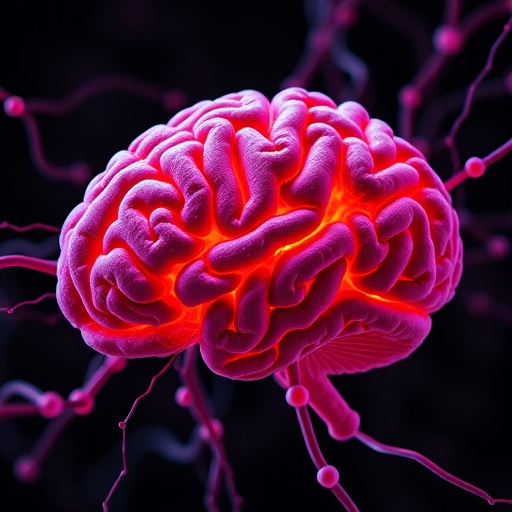
In a groundbreaking study published in Cell Research in 2025, researchers have unveiled a critical molecular mechanism responsible for age-related decline in contextual fear memory. The team led by Jin, Yang, Guo, and colleagues has identified that downregulation of neuronal pentraxin (NPTX) disrupts engram networks in the brain, directly contributing to memory deficits commonly observed in aging populations. This discovery sheds new light on the complex interplay between synaptic connectivity and memory encoding, offering promising avenues for therapeutic intervention against cognitive impairments.
Aging invariably leads to a decline in cognitive functions, with memory loss being among the most distressing symptoms for individuals worldwide. While the general vulnerability of the aging brain to degeneration is well documented, the precise cellular and molecular underpinnings of memory decline have remained elusive. The current study addresses this gap by focusing on engram networks—specialized circuits of neurons believed to encode and store memories. By investigating changes in these networks during aging, the researchers provide a fresh perspective on how memory deterioration unfolds at the synaptic level.
Central to the study’s findings is the neuronal pentraxin family, particularly NPTX2, a protein known to regulate synaptic plasticity and excitatory synapse function. Engrams rely heavily on stable synaptic connections to maintain durable memory traces. The downregulation of NPTX observed in aged mice directly correlates with weakened synaptic strength and disrupted communication within these memory circuits. Using a combination of behavioral assays, molecular biology techniques, and advanced imaging, the investigators meticulously charted the impact of NPTX reduction on the integrity of the engram network.
.adsslot_Ln3SZdzDqp{width:728px !important;height:90px !important;}
@media(max-width:1199px){ .adsslot_Ln3SZdzDqp{width:468px !important;height:60px !important;}
}
@media(max-width:767px){ .adsslot_Ln3SZdzDqp{width:320px !important;height:50px !important;}
}
ADVERTISEMENT
Contextual fear conditioning was utilized as the primary behavioral paradigm, given its well-established reliance on hippocampal function and its relevance for studying associative learning. Older animals exhibited significant deficits in recalling fear-associated contexts, paralleling the downregulation of NPTX and loss of synaptic contacts within key hippocampal regions. This correlation was strengthened further by artificial restoration of NPTX levels, which effectively rescued memory performance and restored synaptic architecture, thus confirming a causative role.
The engram hypothesis posits that memories are preserved in distinct ensembles of neurons, which must maintain precise synaptic configurations to function correctly. The current work elegantly demonstrates how age-related molecular changes in synapse-regulating proteins destabilize these configurations, leading to impaired retrieval of encoded memories. This disruption manifests not only as weakened synaptic plasticity but also as a breakdown of coordinated neuronal activity, essential for memory expression.
Beyond behavioral and anatomical analysis, the researchers employed in vivo calcium imaging to visualize neuronal activation patterns within the engram network during memory recall. In aged mice, these patterns were disorganized and fragmented, mirroring the molecular and synaptic abnormalities identified. In contrast, restoring NPTX expression normalized these neural dynamics, highlighting a direct link between molecular expression, network integrity, and functional memory performance.
The mechanistic insights provided by this study have profound implications for understanding the aging brain’s vulnerability. While previous research often focused on gross neuronal loss or amyloid pathology, this work emphasizes subtler yet equally detrimental molecular and synaptic alterations that precede overt degeneration. It reveals that therapeutic strategies aiming at bolstering synaptic protein expression and preserving engram networks could delay or reverse cognitive decline.
Interestingly, the study also suggests that NPTX acts as more than a passive structural component. It appears to actively modulate the balance of excitation and inhibition within engram circuits, dictating the fidelity of memory retrieval. This dual role positions NPTX as a key regulatory node vulnerable to age-related molecular dysregulation. Understanding how its signaling pathways are influenced by systemic aging factors, such as oxidative stress and inflammation, could open new diagnostic and therapeutic frontiers.
Additional analyses examined the relationship between NPTX expression and other synaptic proteins, revealing that the decline is part of a broader synaptic vulnerability signature in aged brains. This suggests that interventions targeting a network of synaptic regulators may offer more robust protection than focusing on single molecules. Importantly, the study’s model provides a benchmark for future investigations into how environmental enrichment, lifestyle factors, or pharmacological agents could mitigate decline in engram stability.
The translational potential of these findings is immense. With cognitive aging posing a significant public health challenge, strategies derived from this molecular understanding might be harnessed to design drugs or gene therapies aimed at preserving or restoring engram function. Early-phase clinical trials could investigate whether enhancing NPTX pathways improves memory performance in elderly populations or those at risk for neurodegenerative diseases.
Moreover, this research invites a reconsideration of how memory deficits in aging are diagnosed. Current neuropsychological tests might be supplemented with biomarkers reflecting NPTX levels or synaptic network integrity, enabling earlier detection of memory impairment and more personalized therapeutic interventions. Such approaches align with the burgeoning field of precision medicine in neurodegeneration.
Future studies building on these results may explore the interplay between NPTX downregulation and other aging hallmarks like mitochondrial dysfunction, neuroinflammation, and vascular impairment. Clarifying these relationships could help decipher whether NPTX-related synaptic vulnerabilities serve as early harbingers of broader brain aging or function downstream of other damaging processes.
It is also worth noting the technical rigor and innovation displayed in the investigation. The fusion of molecular biology, high-resolution imaging, behavioral neuroscience, and computational analysis represents a commendable integration that maximizes insight into the aging brain’s complex network dynamics. This multidisciplinary approach may serve as a model for future cognitive aging research.
In conclusion, the study by Jin and colleagues delivers a substantial leap forward in deciphering the molecular basis of age-related memory decline. By establishing NPTX downregulation as a critical factor in the disruption of engram networks underpinning contextual fear memory, they illuminate a novel target for combating cognitive aging. As the global population ages, such molecular insights will be indispensable for developing effective interventions that preserve memory and enhance quality of life.
These findings open a compelling dialogue between basic neuroscience and clinical application, suggesting that preserving synaptic integrity through modulating proteins like NPTX could become a cornerstone of future memory-enhancing therapies. The study stands as a testament to the continuing power of molecular neuroscience to unravel the enigmas of the aging brain and pave paths toward healthier cognitive longevity.
Subject of Research: The study investigates the molecular and synaptic mechanisms underlying aging-related contextual fear memory deficits, focusing on the role of neuronal pentraxin (NPTX) and engram network disturbances.
Article Title: Disturbed engram network caused by NPTX downregulation underlies aging-related contextual fear memory deficits.
Article References:
Jin, T., Yang, Y., Guo, Y. et al. Disturbed engram network caused by NPTX downregulation underlies aging-related contextual fear memory deficits. Cell Res (2025). https://doi.org/10.1038/s41422-025-01157-w
Image Credits: AI Generated
Tags: age-related cognitive decline researchcognitive decline in aging populationscontextual fear memory and agingengram networks and memory encodingmemory network disruption in agingmolecular mechanisms of aging-related memory lossneuronal pentraxin mechanism in memory lossNPTX downregulation and agingprotein regulation in synaptic functionsynaptic connectivity and cognitive impairmentsynaptic plasticity and memory formationtherapeutic interventions for memory deficits





